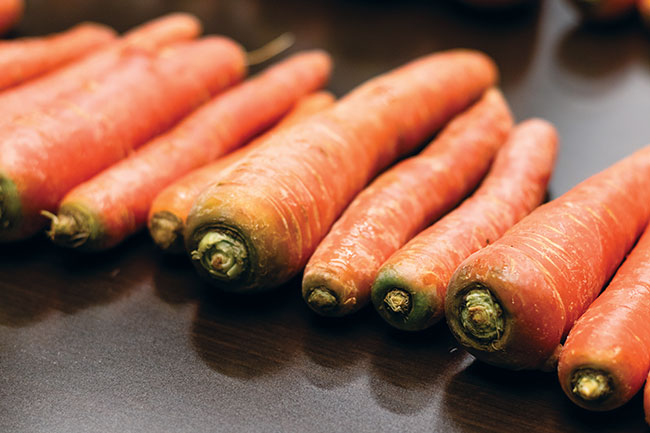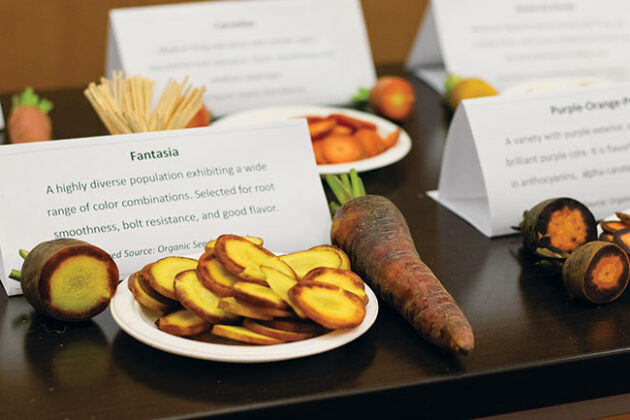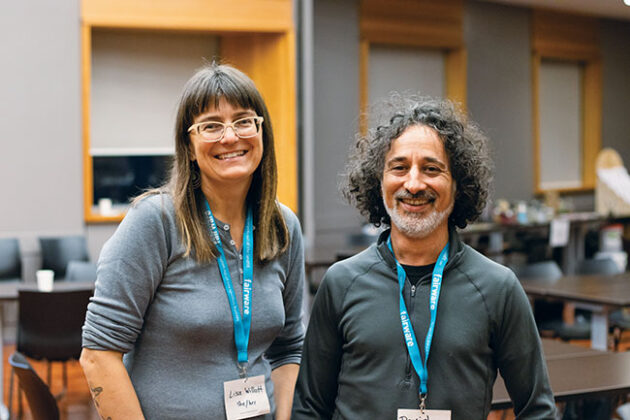
Features
Seed
Vegetables
Sowing the seeds of connection
FarmFolk CityFolk brings seed supporters together to discuss seed growing and sharing as both an art and a science.
March 6, 2024 By Ronda Payne
 Saving the seeds of crop varieties best-suited to a region is one way to preserve food security and adapt to a changing climate.
All photos courtesy of FarmFolk CityFolk.
Saving the seeds of crop varieties best-suited to a region is one way to preserve food security and adapt to a changing climate.
All photos courtesy of FarmFolk CityFolk. Some celebrations come only once a year – like birthdays or anniversaries – but others are so great they come only once every two years, like FarmFolk CityFolk’s biannual B.C. Seed Gathering.
The 2023 event was well attended, and has been over the past six gatherings (including one virtual event), with around 100 people wanting to learn more about seed growing, seed preserving and seed people. Lisa Willott, Vancouver Island seed security program co-ordinator with FarmFolk CityFolk, says it’s the coming together that seems to matter most.
“When you can actually be face-to-face with someone and explain everything about a certain crop, it’s so good,” she says. “It just opens up a whole new world for people.”

This year’s B.C. Seed Gathering included a special focus on carrot selection.
Seed is a big deal
There are plenty of other ways FarmFolk CityFolk opens up the world of seed. The biannual B.C. Seed Gathering is just one element of the B.C. Seed Security program, which is filled with activities and supports for gardeners and farmers alike to appreciate the art and science of seed production.
FarmFolk CityFolk has multiple mobile seed-cleaning trailers that travel the province to help producers prepare seed for sale and have processed over 140,000 pounds of seed. The Citizen Seed Trial invites gardeners and growers from various locations to try different varieties of seeds each year in return for providing comments on aspects like vigour, pest resistance, germination and more (yours truly is a regular participant).
Add to that an Abbotsford-based research seed farm, farmer field days, B.C. seed gatherings and much more, and it’s clear to see the organization understands how essential seed is to feeding the future. This year’s B.C. Seed Gathering also took time to revisit the past and recognize that, while seed-saving may be novel to some farmers, it’s anything but new.
“Something that Rowen White was bringing up that resonated with our farmers is that we’re all connected,” Willott says. “We’ve done [seed-saving] for millennia. People have done it through war-torn countries and brought seeds with them and settled. It’s just part of our culture and that’s a connecting thing.”
The event increased its focus on Indigenous practices with seeds, which Willott says was well received. It provided the understanding that it’s not a new practice, but more of a “stewardship of something that feels really important to us.”
Growing and saving seed
Talking about growing and saving seeds is one thing, but the practice is really quite another. In a talk about seed-growing and saving, David Catzel, B.C. Seed Security program manager and Jolene Swain, Northern seed security program co-ordinator, discussed considerations to keep in mind, not just for beginners but also those who have been saving seed for a while.
Catzel spoke about how he came to appreciate the essential nature of seeds.
“I was at a farm and some person was saving seeds and that just blew my mind. I hadn’t thought that’s how we got that next generation of plants,” he says. “Nowadays, I’m constantly trying to convince people that all seed-saving is climate adaptation work. Seed-saving may be the thing that is most important for climate adaptation.”
This emphasized the importance of seed-saving as a community activity, which Swain says also contributes to maintaining one’s sanity.
“If we all try to collect every seed out there, there’s going to be no room left to sit in our houses and we’re going to be so overwhelmed,” she adds.
Therefore, it’s important to identify what is needed to fill the gaps for potential customers, neighbours and seed-swappers.
Willott recently established a new seed-growing site at the Sandown Centre for Regenerative Agriculture in Saanich, B.C. She began with the quarter-acre in 2023, with 20 to 30 varieties and some trial growing.
“I sell some of the seeds to the B.C. Eco Seed Co-op,” she says. “Sometimes there’s a few gaps, and we see if we can fill in those gaps – so I grew those .”
Her seeds also support local seed banks. The produce grown for the trials is donated as food to local groups, as they weren’t intended for seed. She understands the need to be careful about seed-growing and collecting, and Catzel emphasized this in the seed-gathering discussion.
“It’s really easy to gather a collection of seeds,” he says. “But a seed library is about maintenance.”
That means ensuring varieties grown from the library’s seed must not only create the food desired, but there must also be a catch-and-release aspect, where some of the crop goes to refill the seed coffers. Those who do so need to make sure they’re completing the seed-saving process correctly, as would anyone looking to sell seed or share it in other ways.

Lisa Willott, Vancouver Island seed security program co-ordinator with FarmFolk CityFolk, and David Catzel, B.C. Seed Security program manager.
Dry, dry and dry again
When saving seed to grow in the future, dryness is your friend, as damp or wet seeds are functionally useless.
“Dry them and then dry them again and then make sure they’re really dry,” says Catzel. “If it’s not indoors in [B.C.’s] climate, they’re not going to dry.”
He suggests drying them with a fan without added heat. Too much heat will put them into a dormant state.
“Stick to 15 degrees to 20 or 25 [degrees Celsius],” says Swain. “But you have to watch the humidity.”
One difficulty of growing and harvesting for seeds while also selling produce or flowers is the temptation to sell instead of save. Patience is key, as is controlling the urge to grab the first mature products. Though, as Catzel says, everyone has their own strategy.
“There’s a very challenging dynamic if you’re doing both things,” he says. “If you’re a flower grower and you’re trying to save seeds, it’s so hard not to pick the flowers, and if you’re a vegetable farmer, we harvest the best for our customers.”
He suggests marking off certain areas for seed production and ignoring its food potential. Swain does the same, setting aside certain rows for seed.
“It’s kind of challenging at first, because you look at that row and think, ‘I could just harvest that and sell it,’” she says. “But if you’re growing it for seed, you have to keep taking care of it.”
Keep detailed records
Seed growing involves a lot of record-keeping, as the plants grown for seed need to be tended longer than a regular crop would. This means capturing additional data.
“I find paper and notebooks are the way to go for most farmers, unless you’re into apps and spreadsheets,” Swain says. “Always write it down and then take it to your online record-keeping.”
Catzel likes using photo albums in his phone, and notes that people often fall victim to the thought that they’ll remember to write it down.
“I keep having to learn the same lesson over and over,” he says. “If you’re going to record, do it now.”
Even more than maintaining the existence of many crop varieties, seed-growing and saving are about ensuring the best-suited varieties for a region are available as summer temperatures climb and flooding and droughts persist.
“Of course we’re going to need to keep growing seeds, especially as the climate crisis continues,” says Willott. “We just need to keep it as robust as we can, and having community is going to keep it stronger.” •
Print this page